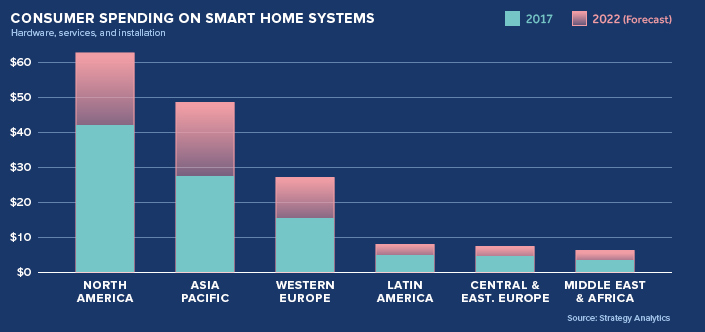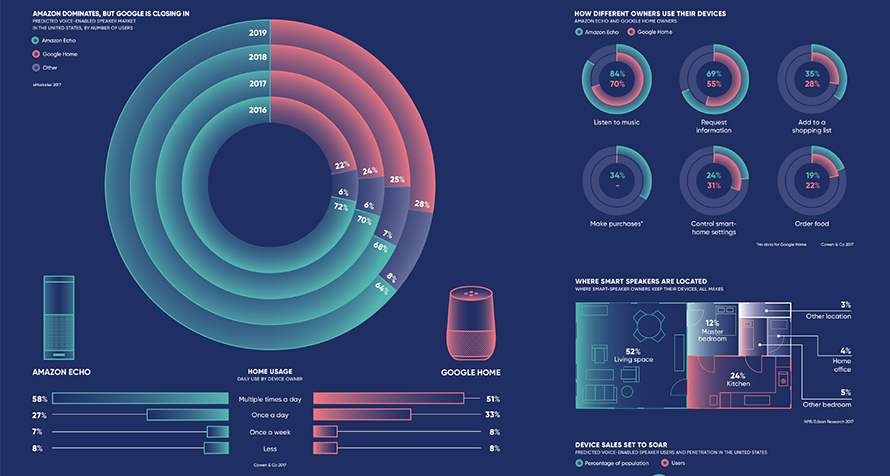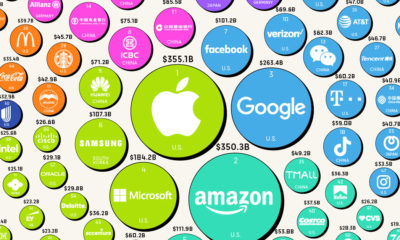Though that dream may not be realized in the short term, sales of smart speakers are increasing as people warm up to the idea of using voice-assisted devices in their homes. Today’s infographic, from Raconteur, sheds light on the fight for smart speaker market share, how early adopters are using the devices, and the growing array of voice-enabled devices currently on the market.
Moving into the Mainstream
The recent flurry of holiday device buying seems to support this prediction. Smart speaker sales in the U.S. rose sharply to nearly 25 million in 2017, with close to 11 million purchased during the holiday season. Thanks to lower price points and wider distribution, this trend will likely continue through 2018 and beyond.
Competition is Heating Up
The two tech giants are fighting hard for the early majority because smart speakers are such a powerful gateway into their ecosystem of services and data collection. Perhaps anticipating a binary market, Sonos is looking to win by taking a slightly different approach. Since the company is doesn’t have an existing suite of consumer services, it’s shipping devices with Alexa integration and opening up the platform to developers (think voice-activated apps). Customers who are suspicious of ulterior motives and integration limitations of the larger brands may gravitate toward a more open, agnostic approach. – Antoine Leblond, VP of Software Development at Sonos To add even more excitement to the race for market share dominance, Apple is launching a smart speaker called HomePod in early 2018.
The Path to IoT is Voice Enabled
For now, smart speakers are primarily a fancy way to people to stream music or get tomorrow’s weather forecast, but they are a critical first step in the impending shift toward the “connected home”. Most people don’t currently live in a place that supports full-on integration with smart speakers, but once they begin using voice-enabled devices, they are more likely to take smaller steps such as rewiring light switches.
33 years after the debut of The Clapper, tech companies have found a better (and far more profitable) hands-free way to turn the lights out. on But fast forward to the end of last week, and SVB was shuttered by regulators after a panic-induced bank run. So, how exactly did this happen? We dig in below.
Road to a Bank Run
SVB and its customers generally thrived during the low interest rate era, but as rates rose, SVB found itself more exposed to risk than a typical bank. Even so, at the end of 2022, the bank’s balance sheet showed no cause for alarm.
As well, the bank was viewed positively in a number of places. Most Wall Street analyst ratings were overwhelmingly positive on the bank’s stock, and Forbes had just added the bank to its Financial All-Stars list. Outward signs of trouble emerged on Wednesday, March 8th, when SVB surprised investors with news that the bank needed to raise more than $2 billion to shore up its balance sheet. The reaction from prominent venture capitalists was not positive, with Coatue Management, Union Square Ventures, and Peter Thiel’s Founders Fund moving to limit exposure to the 40-year-old bank. The influence of these firms is believed to have added fuel to the fire, and a bank run ensued. Also influencing decision making was the fact that SVB had the highest percentage of uninsured domestic deposits of all big banks. These totaled nearly $152 billion, or about 97% of all deposits. By the end of the day, customers had tried to withdraw $42 billion in deposits.
What Triggered the SVB Collapse?
While the collapse of SVB took place over the course of 44 hours, its roots trace back to the early pandemic years. In 2021, U.S. venture capital-backed companies raised a record $330 billion—double the amount seen in 2020. At the time, interest rates were at rock-bottom levels to help buoy the economy. Matt Levine sums up the situation well: “When interest rates are low everywhere, a dollar in 20 years is about as good as a dollar today, so a startup whose business model is “we will lose money for a decade building artificial intelligence, and then rake in lots of money in the far future” sounds pretty good. When interest rates are higher, a dollar today is better than a dollar tomorrow, so investors want cash flows. When interest rates were low for a long time, and suddenly become high, all the money that was rushing to your customers is suddenly cut off.” Source: Pitchbook Why is this important? During this time, SVB received billions of dollars from these venture-backed clients. In one year alone, their deposits increased 100%. They took these funds and invested them in longer-term bonds. As a result, this created a dangerous trap as the company expected rates would remain low. During this time, SVB invested in bonds at the top of the market. As interest rates rose higher and bond prices declined, SVB started taking major losses on their long-term bond holdings.
Losses Fueling a Liquidity Crunch
When SVB reported its fourth quarter results in early 2023, Moody’s Investor Service, a credit rating agency took notice. In early March, it said that SVB was at high risk for a downgrade due to its significant unrealized losses. In response, SVB looked to sell $2 billion of its investments at a loss to help boost liquidity for its struggling balance sheet. Soon, more hedge funds and venture investors realized SVB could be on thin ice. Depositors withdrew funds in droves, spurring a liquidity squeeze and prompting California regulators and the FDIC to step in and shut down the bank.
What Happens Now?
While much of SVB’s activity was focused on the tech sector, the bank’s shocking collapse has rattled a financial sector that is already on edge.
The four biggest U.S. banks lost a combined $52 billion the day before the SVB collapse. On Friday, other banking stocks saw double-digit drops, including Signature Bank (-23%), First Republic (-15%), and Silvergate Capital (-11%).
Source: Morningstar Direct. *Represents March 9 data, trading halted on March 10.
When the dust settles, it’s hard to predict the ripple effects that will emerge from this dramatic event. For investors, the Secretary of the Treasury Janet Yellen announced confidence in the banking system remaining resilient, noting that regulators have the proper tools in response to the issue.
But others have seen trouble brewing as far back as 2020 (or earlier) when commercial banking assets were skyrocketing and banks were buying bonds when rates were low.

















